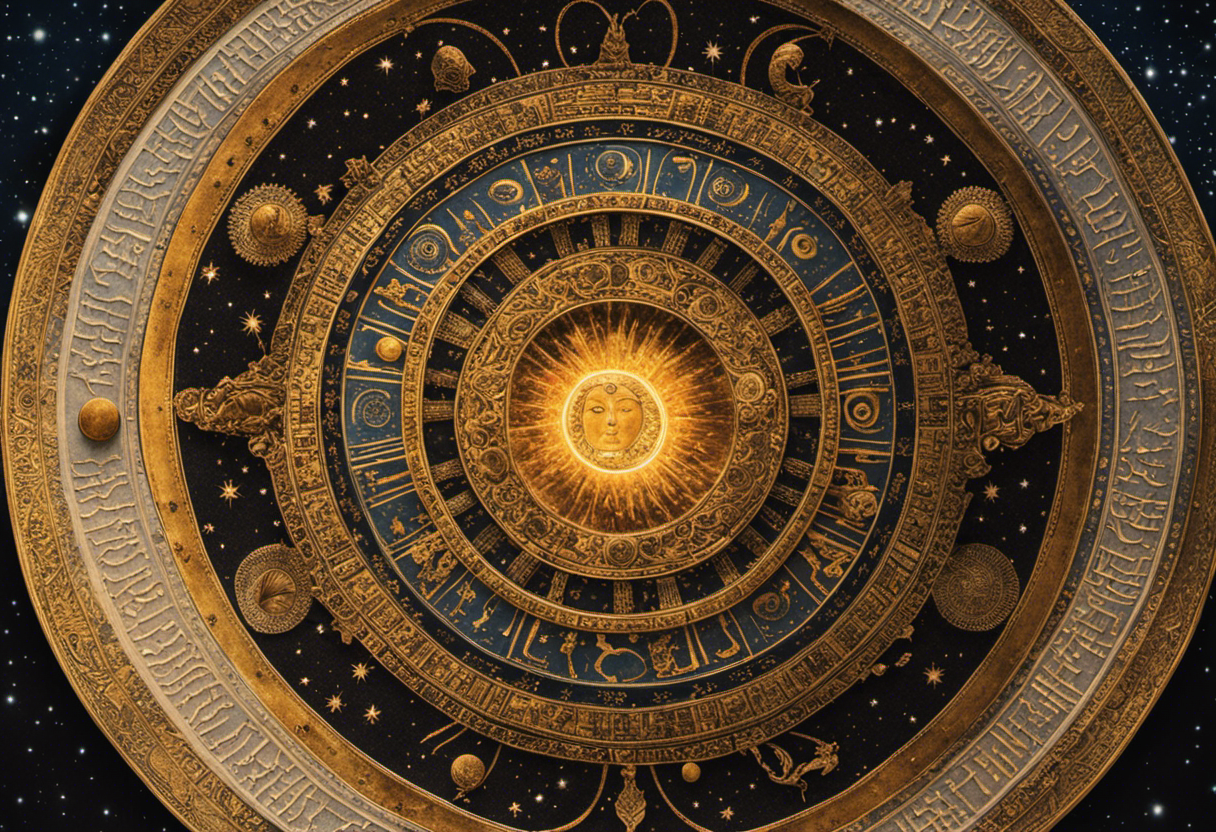In the realm where ancient wisdom and celestial mysteries converge, the connection between Zoroastrianism and astronomy illuminates a fascinating tapestry of belief and observation.
Drawing upon centuries of tradition and profound reverence for the cosmos, Zoroastrian cosmology intertwines with the study of stars and planets, giving rise to celestial worship, astrology, and divination.
This article delves into the origins of Zoroastrian cosmology, explores the profound influence of Zoroastrianism on ancient astronomy, and examines modern perspectives on this captivating connection.
Key Takeaways
- Zoroastrianism, founded in the 6th century BCE, incorporates dualistic beliefs about the universe and the struggle between good and evil.
- Celestial bodies such as stars and planets are seen as divine beings in Zoroastrianism and are believed to influence human destiny.
- Celestial worship is an important part of Zoroastrianism, with seven celestial bodies recognized as divine manifestations, each representing specific qualities and powers.
- Zoroastrianism incorporates astrology and divination, using celestial observations and interpretations as tools for self-reflection, guidance, and decision-making.
Origins of Zoroastrian Cosmology


The origins of Zoroastrian cosmology can be traced back to ancient Persian beliefs and practices. Zoroastrianism, founded by the prophet Zoroaster in the 6th century BCE, is one of the oldest known monotheistic religions. Zoroastrian cosmology is centered around the concept of a dualistic universe, with the forces of good and evil in constant conflict. This understanding of the world was deeply influenced by the ancient Persians’ close observation of the natural world, including the movements of celestial bodies.
Ancient Persians believed that the cosmos was divided into three realms: the sky, the earth, and the underworld. The sky, known as the ‘heavens,’ was considered the abode of the gods and the source of all good. It was believed to be a realm of light and purity, where the sun, moon, and stars resided. The earth, on the other hand, was seen as a battleground between the forces of good and evil. The underworld, or ‘hell,’ was believed to be a realm of darkness and chaos, where evil spirits dwelled.
The ancient Persians’ understanding of the cosmos was not merely theoretical but deeply intertwined with their religious and moral beliefs. They saw the movements of celestial bodies as manifestations of the eternal struggle between good and evil. The sun, for example, was seen as a symbol of light and purity, while the moon represented darkness and evil. This understanding of the cosmos played a crucial role in shaping the moral code of Zoroastrianism, which emphasized the importance of choosing the path of righteousness and resisting evil.
Zoroastrian Beliefs About the Stars and Planets


Zoroastrian cosmology attributes spiritual significance to the movements and alignments of the stars and planets, reflecting the belief in a divine order beyond the earthly realm. The ancient Persian religion of Zoroastrianism, founded by Zarathustra (Zoroaster) in the 6th century BCE, places great importance on celestial symbolism and incorporates astronomical rituals into its religious practices.
In Zoroastrianism, the stars and planets are seen as manifestations of divine beings and are believed to influence human destiny. The alignment of celestial bodies is considered to be a reflection of the cosmic order and is therefore closely observed and interpreted. This celestial symbolism is found in various Zoroastrian texts, such as the Avesta, which describe the significance of different constellations and their association with specific deities.
Astronomical rituals are an integral part of Zoroastrian worship. These rituals involve the observation and worship of celestial bodies, such as the sun, moon, and stars. Zoroastrians believe that by participating in these rituals, they can align themselves with the cosmic order and maintain harmony between the earthly and divine realms.
Overall, the connection between Zoroastrianism and astronomy highlights the profound spiritual significance attributed to the movements and alignments of the stars and planets. The belief in a divine order beyond the earthly realm is deeply ingrained in Zoroastrian cosmology and continues to shape the religious practices of this ancient faith.
Celestial Worship in Zoroastrianism


One of the key aspects of celestial worship in Zoroastrianism is the recognition of the seven celestial bodies as divine manifestations. This celestial symbolism plays a significant role in religious rituals and practices of this ancient faith.
The sun, as the most prominent celestial body, represents Ahura Mazda, the supreme deity in Zoroastrianism. It symbolizes purity, enlightenment, and the source of life and energy.
The moon is associated with the goddess Anahita, representing fertility, femininity, and nourishment. It is also seen as a protector against evil forces.
The stars are considered the souls of the departed and are venerated as celestial beings. They guide the souls on their journey after death and are believed to have a direct influence on human destiny.
The planets are seen as divine entities with specific qualities and powers. For example, Mercury represents intelligence and communication, while Mars represents strength and courage.
These celestial bodies are not worshipped directly but serve as symbols and intermediaries between humans and the divine. Rituals such as prayers, offerings, and observances are performed to honor and seek blessings from these celestial beings.
Through this celestial worship, Zoroastrians seek to align themselves with the divine order and maintain harmony in the universe.
Astrology and Divination in Zoroastrian Tradition


Astrology and divination play integral roles in Zoroastrian tradition, providing individuals with insights into their personal destinies through the interpretation of celestial movements and signs. Zoroastrianism, one of the world’s oldest religions, has a deep connection with astronomy, as evidenced by its astrology practices and divination methods.
Astrology in Zoroastrianism involves the study of celestial bodies and their positions to understand their influence on human lives. The movements of the stars and planets are believed to reflect divine messages and can reveal valuable information about a person’s character, fate, and future. Zoroastrians consult astrologers, known as mobeds, who possess specialized knowledge and skills in reading the celestial signs.
Divination is another important aspect of Zoroastrian tradition. It involves various methods, such as interpreting dreams, analyzing the flight patterns of birds, and observing the behavior of animals, to gain insights and guidance. Divination is seen as a means of communicating with the divine and seeking answers to important questions or decisions.
Both astrology and divination serve as tools for self-reflection, guidance, and decision-making in Zoroastrianism. They allow individuals to gain a deeper understanding of their place in the universe and their relationship with the divine. While these practices may vary in interpretation and application, they remain significant components of Zoroastrian religious and cultural life.
Zoroastrian Influence on Ancient Astronomy


The significant influence of Zoroastrian beliefs on ancient astronomy is evident through the incorporation of celestial observations and interpretations into religious rituals and practices. Zoroastrianism, one of the world’s oldest religions, developed in ancient Persia around the 6th century BCE. It placed a strong emphasis on the worship of nature and the elements, and this included a deep understanding and appreciation of the celestial bodies.
Zoroastrian celestial observations played a crucial role in determining the timing of religious festivals and rituals. The position and movement of the sun, moon, and stars were carefully studied to mark important occasions such as the vernal equinox and the winter solstice.
Zoroastrians believed that the celestial bodies were embodiments of divine entities. The sun, for example, was associated with Ahura Mazda, the supreme deity in Zoroastrianism. This belief led to the development of a complex system of astrology, where the movements and positions of celestial bodies were believed to provide insights into human destiny.
Zoroastrianism also influenced the development of ancient Persian astronomy. The religion’s emphasis on the importance of celestial observations and their connection to divine forces motivated scholars to study and document the movements of the stars and planets. This knowledge later influenced the astronomy of neighboring civilizations, such as the Greeks.
Overall, the influence of Zoroastrian beliefs on ancient astronomy was profound. It not only shaped religious rituals and practices but also contributed to the development of astrology and astronomy in the ancient world.
Modern Perspectives on the Zoroastrian-Astronomy Connection


Several contemporary scholars have explored the intricate relationship between Zoroastrianism and astronomy, shedding new light on the ancient connection and its relevance to modern understanding. Through modern interpretations and scientific evidence, these scholars have deepened our understanding of how Zoroastrianism utilized astronomical knowledge in its religious practices and rituals.
One of the key aspects of Zoroastrianism is its emphasis on the duality of good and evil. Scholars have found that this dualistic worldview is reflected in the Zoroastrian calendar, which is based on the observation of celestial events such as solstices and equinoxes. The alignment of these events with specific religious festivals underscores the importance of astronomical observations in Zoroastrian religious life.
Furthermore, Zoroastrian texts contain references to celestial bodies, such as the sun, moon, and stars, and their symbolic significance. For example, the sun is often associated with divine power and enlightenment, while the moon represents purity and fertility. These celestial symbols serve to reinforce the Zoroastrian belief in the cosmic struggle between good and evil.
Conclusion
In conclusion, the connection between Zoroastrianism and astronomy can be likened to a tapestry woven with threads of ancient beliefs, celestial worship, and astrological practices.
Through their cosmological understanding, Zoroastrians developed a profound reverence for the stars and planets, incorporating them into their religious rituals and divination practices.
Furthermore, Zoroastrianism’s influence on ancient astronomy cannot be understated, as it played a significant role in shaping early scientific observations and understandings of the cosmos.
This rich historical connection continues to be explored and appreciated in modern perspectives.



